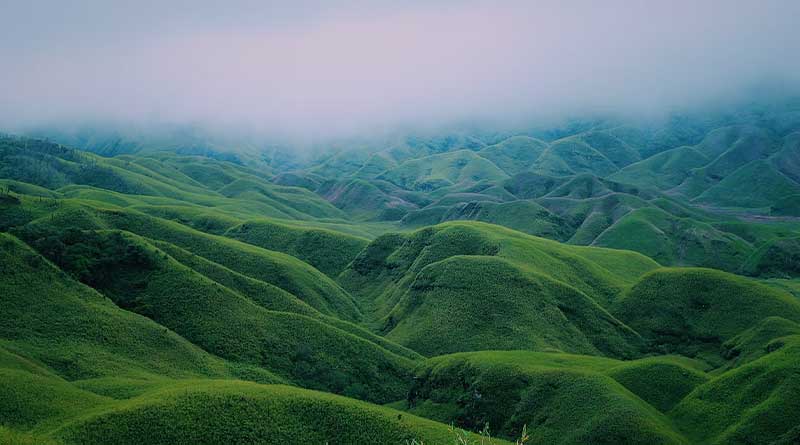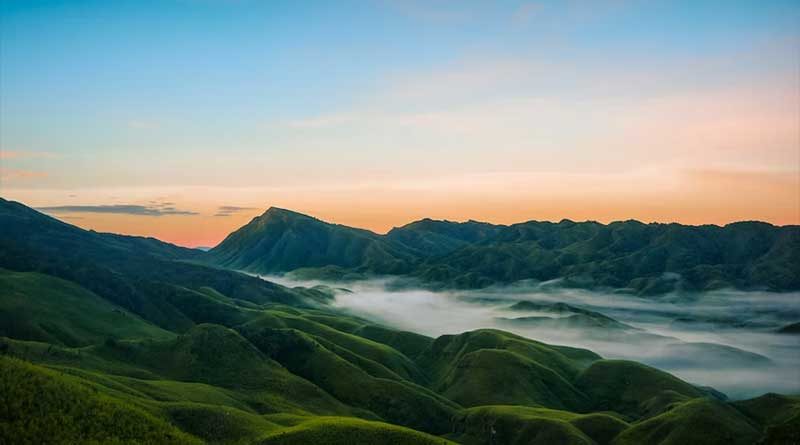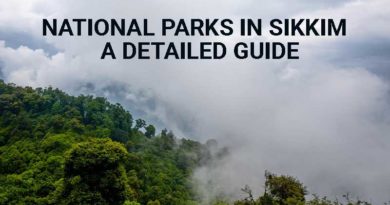National Parks in Nagaland – A Detailed Guide for Visitors
Hidden in the garb of lush green forest and rocky mountains, Nagaland is situated at the far northeast of the Indian Subcontinent. This 16th state of the Indian Union is gifted with rich flora and fauna to a point that almost one-sixth of its region is covered with forests.
The primary type of flora found in Nagaland is tropical and subtropical evergreen forests, containing bamboo, palms, mahogany, rattan, and more. Apart from that, in some alleviated areas one can find coniferous trees too.
Nagaland is home to many endemic species making it a great destination for nature lovers and research scholars. Moreover, you’ll also find lots of national parks and wildlife sanctuaries there.
Best National Parks in Nagaland
With an abundance of lush greenery and wildlife, Nagaland houses many national parks that will help you escape the monotonous hustle and bustle of city life.
These national parks do not just satiate your inner nature lover but also serve your adventurous self with activities like camping, trekking, hiking, and bird or animal watching. In addition, the national parks are surrounded by many local villages of different tribes of Nagaland.
So, a visit to the national park also gives you a chance to experience a local lifestyle. Here are some of the best National Parks in Nagaland that you should add to your bucket list.
1. Ntangki National Park
Locally known as, ‘Intanki’, Ntangki National Park is the largest national park in Nagaland. It covers a total area of 202.02 sq km.
The dense jungle that is reserved as the National Park today is home to various flora and fauna. From trees like mahogany, palms, bamboo, and rattan to flora such as Cymbidium tigrinum, Pleoni, Oroxylum Indicum, etc. sway to the rhythm of nature as you explore deep into the park.
For people who are excited about the idea of watching birds and animals, endemic faunas such as Mithun, a subcategory of Gaur, the state bird Hornbill, the rare faunal species of Hoolock gibbon, sloth bears, tigers, and leopards are in abundance in the park.
How to Reach: The journey to Ntangki National Park is certainly an important aspect of the whole journey. Nagaland is in the far east of India, making it distant from most parts of the country.
But reaching Ntangki national park can be made easier with the proper knowledge and planning.
- By Rail: The nearest railway station to reach Ntangki National Park is Dimapur. Guwahati is the connecting railway station to Dimapur. Therefore, travelers can reserve tickets from Guwahati to reach Dimapur. It is a 5 to 6 hours journey by train from Guwahati to Dimapur after which you can rent a car from the station to Ntangki National park.
- By road: To reach the park by road, you can rent a car directly from Guwahati Railway station or Guwahati Airport to Ntangaki national park. The journey timing will be around 4 to 5 hours. Another option for road transportation is the bus. Peren district has its bus terminus that houses buses from Guwahati. You can get on a bus from Guwahati to Peren and reach Ntangki National park.
- By Air: Nagaland has its airport in Dimapur. You can book your flight from any major Indian airport and reach Dimapur in just 2 to 3 hours. An option for spot booking is available at the airport. You can rent a car from the airport directly to Ntnagki National park.
Fees: No fee is needed to enter the Ntangki National park. However, you need official permission from the Nagaland forest department.
2. Fakim Wildlife Sanctuary
This wildlife sanctuary was established in the year 1980. It is located in Pungro circle, Kiphire District of Nagaland, which is very close to the Myanmar border. Because of the heavy rainfall in this part of the state, Fakim Wildlife Sanctuary has very dense vegetation.
This wildlife sanctuary covers an area of 6.4 sq km. Apart from rich flora and fauna, the Fakim wildlife sanctuary has a unique variation in altitudes with high ridges, hills, valleys, and deep gorges. This makes its vegetation equally varied.
The most common animals seen in this sanctuary are Panther, Loris, Barking deer, Himalayan beer, and hoolock gibbon. Birds like green hornbill, jungle fowl, doves, and tragopan can be seen as you look around the jungle.
A unique attraction of Fakim wildlife sanctuary is the many kinds of orchids and fern flowers. It is because of the heavy rainfall in the region.
How To Reach: Travelers can reach Fakim Wildlife Sanctuary in three ways. Dimapur is the gateway to Nagaland as it connects the state via airport and railway.
This wildlife sanctuary is the farthest of all the other sanctuaries from Dimapur. You can reach this sanctuary only by road. The time taken to reach this wildlife sanctuary is around 11 hours from Dimapur.
- By Air: Dimapur is the nearest airport to Pungro. The Dimapur airport is connected to all the domestic Indian airports. From the airport, you can rent a car to Pungro. There is a trek of two hours from Pungro to the main sanctuary.
- By Rail: The nearest railway station is Dimapur. You can book a ticket from Guwahati to Dimapur. Thereafter, you can either rent a car or take a bus to Pungro.
- By Road: To reach the sanctuary by road, you can book a car or board a bus. You will find the bus from Dimapur. Private as well as government buses are available for visitors to reach Pungro.
Fee: Free
3. Rangapahar Wildlife Sanctuary
This would be one of the most easily accessible wildlife sanctuaries in Nagaland. It is situated in Dimapur and was set up in 1986. It covers an area of 4.7 sq km.
Rangapahar wildlife sanctuary can easily be a go-to destination for families because of its location within Dimapur. This sanctuary is unique for being a shelter for a lot of birds. Hence, bird watchers are mostly attracted to Rangapahar Wildlife Sanctuary.
Alongside the scenic beauty, sightings of some endangered animals like hoolock gibbon, Mithun, sloth bear, tailed pig, etc. add an interesting and knowledgeable touch to such expeditions.
How To Reach: Due to its location within Dimapur town, reaching Rangapahar Wildlife sanctuary is quite convenient.
- By Air: Land at Dimapur airport and get a taxi or bus or auto rickshaw to Rangapahar Wildlife sanctuary.
- By Road: Reach Dimapur by bus, car, or train. Once you are in Dimapur, traveling to this sanctuary becomes easier. You can take an auto, car, or bus to reach the sanctuary.
- By Rail: Board the train from Guwahati if you choose to go by train from Assam or you can take the direct train from your location to Dimapur railway station.
Fee: Free
4. Pulie Badze Wildlife Sanctuary
Pulie Badze is the second most visited wildlife sanctuary after Ntangki National Park. It is a 9.23 sq km catchment area located adjacent to the famous Dzuko Valley (100 sq km) and Japfu peak, the second-highest peak in Nagaland. The latter areas have been designated as Important Bird Areas (IBA).
Adjacent to Dzukou valley is another community-protected area viz. Khonoma Nature Conservation and Tragopan Sanctuary. Travelers can visit these places too.
Travelers visiting this sanctuary can not only enjoy the wildlife of the area but also hike through Dzuko valley. While Pulie Badze forest is home to some rare and endangered Avi faunal species like Dark Rumped Swift and Blyth’s Tragopan, Dzuko Valley harbors the endemic Dzukou Lily Lilium Chitrangade.
How To Reach: Pulie Badze Wildlife sanctuary is located in Kohima, the capital of Nagaland. Kohima is only two hours away from Dimapur, the gateway to Nagaland.
- By Air: Take a flight to Dimapur. From the airport, board a bus or rent a car to Kohima. Traveling to Pulie Badzie is quite easy.
- By Road: Book a taxi from Dimapur or board a bus (private or government) to Kohima. Once in the town, you can take an auto, rented car, or bus to Pulie Badze Wildlife Sanctuary.
- By Rail: After reaching Dimapur Railway station, you can reach Pulie Badze Wildlife Sanctuary via roadways easily.
Fee: Free
5. Singphan Wildlife Sanctuary
This Sanctuary falls under the Mon District of Nagaland. It is the latest addition to the wildlife conservation area in Nagaland.
The forests found in this sanctuary have different names such as Shingan forest, Wangching forest, Tiru forest, Zangkhum forest, Shawot, and Chen forest. All these forests are rich in timber.
Some of the well-known floras found in this Singphan are Blue Vanda, White Orchids, Foxtail Orchids, wild Lilies, and Maples. You can find numerous medicinal herbs of great botanical value in this sanctuary.
Tourists traveling to Singphan Wildlife Sanctuary can get a chance to see endangered elephants, the rare Tragopan, barking Deer, Mountainous goats, wild boars, bears, etc.
How to Reach: Reaching Singphan Wildlife Sanctuary is relatively difficult due to no direct connectivity.
- By Air: One can take a flight to Jorhat (Assam) and then travel by bus to Mon. Since there is no direct bus service to Mon, you can take a bus to Sonari or Simulguri and then from there board another bus to Mon.
- By Road: No direct bus service to Mon. You have to reach Sonari or Simulguri to take a bus to Mon.
- By Rail: There is no rail connectivity to Mon. You can deboard at Bhoju railway station, Assam, and then head towards Mon via. Sonari.
Fee: Free
Do’s and Don’ts While Visiting a National Park

What Not To Do At A National Park
- Keep a Safe Distance From Animals
Keep close to your guide at all times and do not try to disrupt the peace of animals. Since they are retained in their natural sanctuary, they have not been trained to not attack humans. Hence, to avoid accidents and mishaps, you should admire animals from a safe distance. Always be at least around 20 m away from them.
Do not make sudden movements around animals as it can scare them.
- Do Not Litter The Park
Leaving man-made objects can harm the ecosystem. Cleaners at the national parks are not able to clean many areas of the park. Therefore, not leaving behind litter is the responsibility of the visitors. Visitors should be careful about their personal belongings too.
- Do Not Make Noise In The Park
Disturbing the peace of nature with loud music or noise can be alarming for the animals in the park. Hence, it can lead to hindrances in the expedition.
- Do Not Smoke In The Park
Smoking is prohibited in national parks as it can cause severe forest fire accidents. Smoke can be a disturbance for other visitors too as it can alarm wild animals also.
How To Maintain Decorum At A National Park
- Keep Your Phone On Silent Mode
Making unnecessary noise is a big no-no in National Park. It can disrupt the peace of nature. Loud Ringtones, music playing on phones, or talking loudly on the phone can alert the animals and can cause an uncalled animal attack.
- Avoid Gatherings
At national parks, one should always avoid gatherings and crowding as it can lead to people making unnecessary noises. Animals can perceive large gatherings as a threat and hence go for an attack.
- Be Aware Of Your Surroundings
Keep interacting with your local guide, as they can remind you of the precautions you should take in a forest. Your guide knows more about the area than you, so asking them questions and conversing with them can enhance your jungle experience.
- Abide By The Rules Of The National Park
Obeying the rules ordered by the concerned authorities of respective reserved areas should be the number one priority. Park your vehicles only at the designated places.
- Carry Useful Objects
Carrying binoculars and cameras can be a wise choice. The authorized vehicles cannot enter a lot of places, especially very close to the animals. Hence, binoculars can help you see far-off animals clearly.
- Be Mindful
Enjoy the experience of wildlife in silence. Look around, and try to see beyond the large creatures. A forest is a beautiful place with a variety of creatures of various sizes and shapes. Keep your senses open to all the sights the National park has to provide.
Related Questions
1. How Many National Parks Are There In Nagaland?
There is only one official national park in Nagaland called the Intanki National Park. Other than that there are 4 wildlife sanctuaries viz. Fakim Wildlife Sanctuary, Pulie Badze Wildlife Sanctuary, Rangapahar Wildlife Sanctuary, and Sangphan Wildlife Sanctuary.
2. What Is The Best Time To Visit The National Parks In Nagaland?
The best time to visit the national parks in Nagaland is February to May or October to November. Monsoon is not a good season to travel in Nagaland.
Final Thoughts
Reserved forests such as National Parks and wildlife sanctuaries are examples of humankind’s efforts to conserve our natural environment. These protected lands should be religiously taken care of as they give us a chance to come face to face with the mysterious workings of nature.
National Parks in Nagaland are not just about the lush green forests and varied wildlife, but it is more about the call for expected attention to the endangered species.
Travelers visiting National Parks in Nagaland may come with an expectation of experiencing the wildlife but we are sure they will leave the place experiencing something more, the beautiful relationship that interacts with the wildlife in Nagaland.



